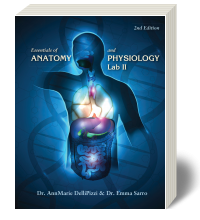

Essentials of Anatomy and Physiology Lab II
Second Edition DelliPizzi, Sarro, © 2018, 679 pages
This textbook is suitable for the second semester of an anatomy and physiology lab.
Request Examination CopyPrices and ISBNs
This title is available in the following formats.
|
Product
Description ISBN |
Description | ISBN | Bookstore (Net Price) |
Student (Retail Price) |
Supplements
The available Supplements are listed below:
Click here to access ancillaries save_altInstant Access (and Coupons)
All students can have free Instant Access to an eBook for the first two weeks of class while they procure their textbook. They will also receive a 10%-off coupon valid at the BVT web store for the best possible price. Get instant access codes here.
Instructor's Manual
Excerpts
Description
The chapter on the Special Senses introduces the students to the anatomy of the organs for gustation, olfaction, hearing and vision and includes physiology based activities for each system. The Endocrine System chapter covers the anatomy of the major organs and includes an iWorx activity allowing students to test the impact of adrenal hormones on cardiovascular parameters. The Cardiovascular System is covered in three separate chapters on Blood, the Heart and Hemodynamics. Students also utilize the iWorx system to understand blood pressure, pulse and the electrocardiogram. The chapter on the Respiratory System covers the histology of lung tissue and incorporates iWorx activities on spirometry measurements. In addition to the organs, the Lymphatic System chapter also includes fundamentals of immunology through the performance of an ELISA test. The Digestive System covers anatomy of all organs and reinforces the basic concepts of biochemistry introduced in manual I. Biochemical tests are used to demonstrate principles of carbohydrate, protein, and lipid digestion. The chapter on the Reproductive System includes not only the anatomy of the organs but on the process of meiosis. A chapter on genetics introduces students to basic principles of Mendelian Genetics and includes an activity to demonstrate genetic variability. Finally, the manual concludes with a complete system by system dissection of the fetal pig.
What’s New in the 2nd Edition
The 2nd edition of Essentials of Anatomy and Physiology Lab II contains several major changes which will provide the students a greater exploration and enhanced understanding of the organ systems in the human body.
This 2nd edition builds onto the original foundation by introducing a General Senses chapter at the beginning of the manual. This chapter engages the students in activities aimed at teaching the touch, temperature and pain somatosensory systems. Histological examination of the generalized sensory receptors enable the students to gain understanding of the system’s anatomy, while several fun and easy activities allow the students to test two-point somatosensory discrimination, temperature acuity, temperature adaptation and proprioception. This chapter also gives students a stronger background of the difference between the general senses and the complicated special senses they encounter in the 2nd chapter.
A second major improvement made to this edition is the merging of activities from the Reproduction and Genetics chapters. The new version of this chapter covers material that leads students from a set of reproductive, anatomy-based activities to applying the principles of human genetics in a fun, hands-on activity.
Finally, a third major change is the addition of a 13th chapter leading students through a dissection of an adult cat, with pictures to help guide the activities. This may serve as an alternative to the dissection of the fetal pig for those that want the experience in examining the mammalian organ systems in a larger and more developed animal. Since both Fetal Pig and Adult Cat dissection chapters are organized in a similar way, students are also able to examine each of the organ systems simultaneously if both lab activities are completed.